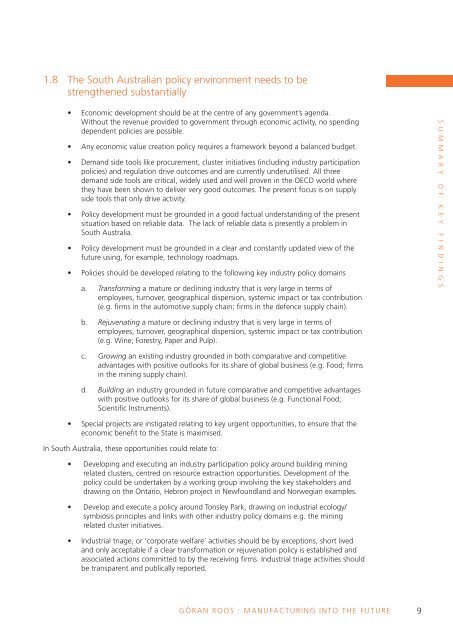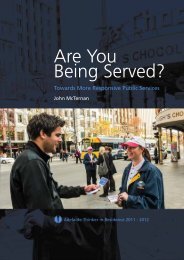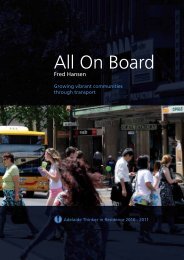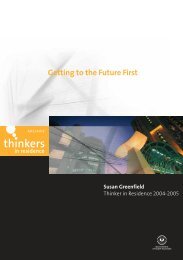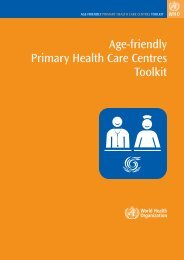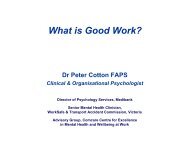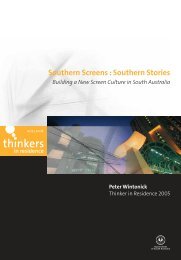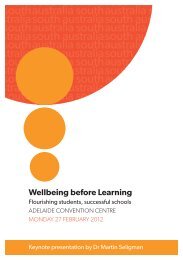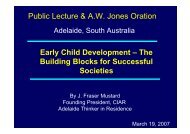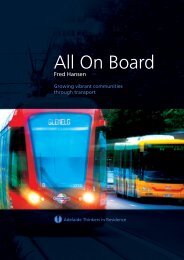Manufacturing into the future - Adelaide Thinkers in Residence - SA ...
Manufacturing into the future - Adelaide Thinkers in Residence - SA ...
Manufacturing into the future - Adelaide Thinkers in Residence - SA ...
- No tags were found...
You also want an ePaper? Increase the reach of your titles
YUMPU automatically turns print PDFs into web optimized ePapers that Google loves.
1.8 The South Australian policy environment needs to bestreng<strong>the</strong>ned substantially• Economic development should be at <strong>the</strong> centre of any government’s agenda.Without <strong>the</strong> revenue provided to government through economic activity, no spend<strong>in</strong>gdependent policies are possible.• Any economic value creation policy requires a framework beyond a balanced budget.• Demand side tools like procurement, cluster <strong>in</strong>itiatives (<strong>in</strong>clud<strong>in</strong>g <strong>in</strong>dustry participationpolicies) and regulation drive outcomes and are currently underutilised. All threedemand side tools are critical, widely used and well proven <strong>in</strong> <strong>the</strong> OECD world where<strong>the</strong>y have been shown to deliver very good outcomes. The present focus is on supplyside tools that only drive activity.• Policy development must be grounded <strong>in</strong> a good factual understand<strong>in</strong>g of <strong>the</strong> presentsituation based on reliable data. The lack of reliable data is presently a problem <strong>in</strong>South Australia.• Policy development must be grounded <strong>in</strong> a clear and constantly updated view of <strong>the</strong><strong>future</strong> us<strong>in</strong>g, for example, technology roadmaps.• Policies should be developed relat<strong>in</strong>g to <strong>the</strong> follow<strong>in</strong>g key <strong>in</strong>dustry policy doma<strong>in</strong>sa. Transform<strong>in</strong>g a mature or decl<strong>in</strong><strong>in</strong>g <strong>in</strong>dustry that is very large <strong>in</strong> terms ofemployees, turnover, geographical dispersion, systemic impact or tax contribution(e.g. firms <strong>in</strong> <strong>the</strong> automotive supply cha<strong>in</strong>; firms <strong>in</strong> <strong>the</strong> defence supply cha<strong>in</strong>).S U M M A R Y O F K E Y F I N D I N G Sb. Rejuvenat<strong>in</strong>g a mature or decl<strong>in</strong><strong>in</strong>g <strong>in</strong>dustry that is very large <strong>in</strong> terms ofemployees, turnover, geographical dispersion, systemic impact or tax contribution(e.g. W<strong>in</strong>e; Forestry, Paper and Pulp).c. Grow<strong>in</strong>g an exist<strong>in</strong>g <strong>in</strong>dustry grounded <strong>in</strong> both comparative and competitiveadvantages with positive outlooks for its share of global bus<strong>in</strong>ess (e.g. Food; firms<strong>in</strong> <strong>the</strong> m<strong>in</strong><strong>in</strong>g supply cha<strong>in</strong>).d. Build<strong>in</strong>g an <strong>in</strong>dustry grounded <strong>in</strong> <strong>future</strong> comparative and competitive advantageswith positive outlooks for its share of global bus<strong>in</strong>ess (e.g. Functional Food;Scientific Instruments).• Special projects are <strong>in</strong>stigated relat<strong>in</strong>g to key urgent opportunities, to ensure that <strong>the</strong>economic benefit to <strong>the</strong> State is maximised.In South Australia, <strong>the</strong>se opportunities could relate to:• Develop<strong>in</strong>g and execut<strong>in</strong>g an <strong>in</strong>dustry participation policy around build<strong>in</strong>g m<strong>in</strong><strong>in</strong>grelated clusters, centred on resource extraction opportunities. Development of <strong>the</strong>policy could be undertaken by a work<strong>in</strong>g group <strong>in</strong>volv<strong>in</strong>g <strong>the</strong> key stakeholders anddraw<strong>in</strong>g on <strong>the</strong> Ontario, Hebron project <strong>in</strong> Newfoundland and Norwegian examples.• Develop and execute a policy around Tonsley Park, draw<strong>in</strong>g on <strong>in</strong>dustrial ecology/symbiosis pr<strong>in</strong>ciples and l<strong>in</strong>ks with o<strong>the</strong>r <strong>in</strong>dustry policy doma<strong>in</strong>s e.g. <strong>the</strong> m<strong>in</strong><strong>in</strong>grelated cluster <strong>in</strong>itiatives.• Industrial triage, or ‘corporate welfare’ activities should be by exceptions, short livedand only acceptable if a clear transformation or rejuvenation policy is established andassociated actions committed to by <strong>the</strong> receiv<strong>in</strong>g firms. Industrial triage activities shouldbe transparent and publically reported.GÖRAN ROOS : MANUFACTURING INTO THE FUTURE9


